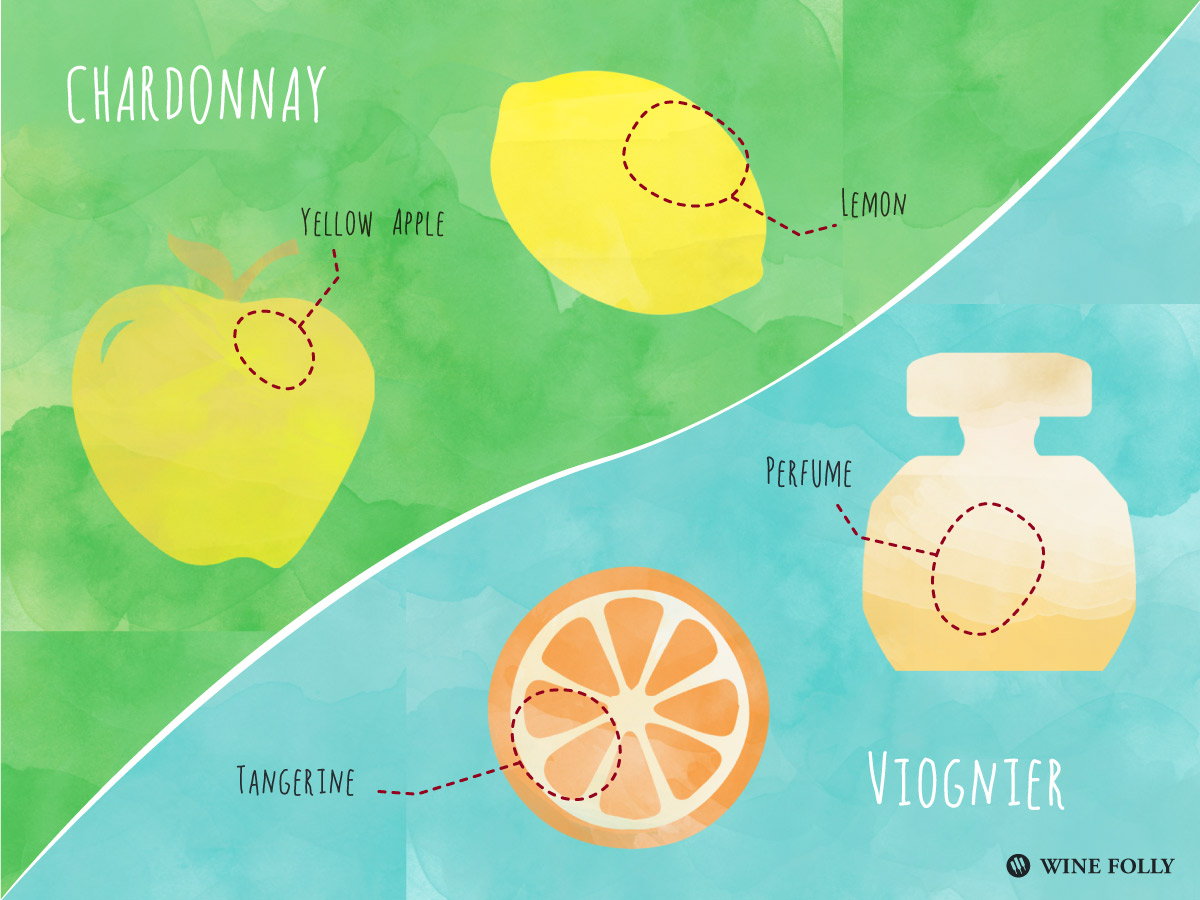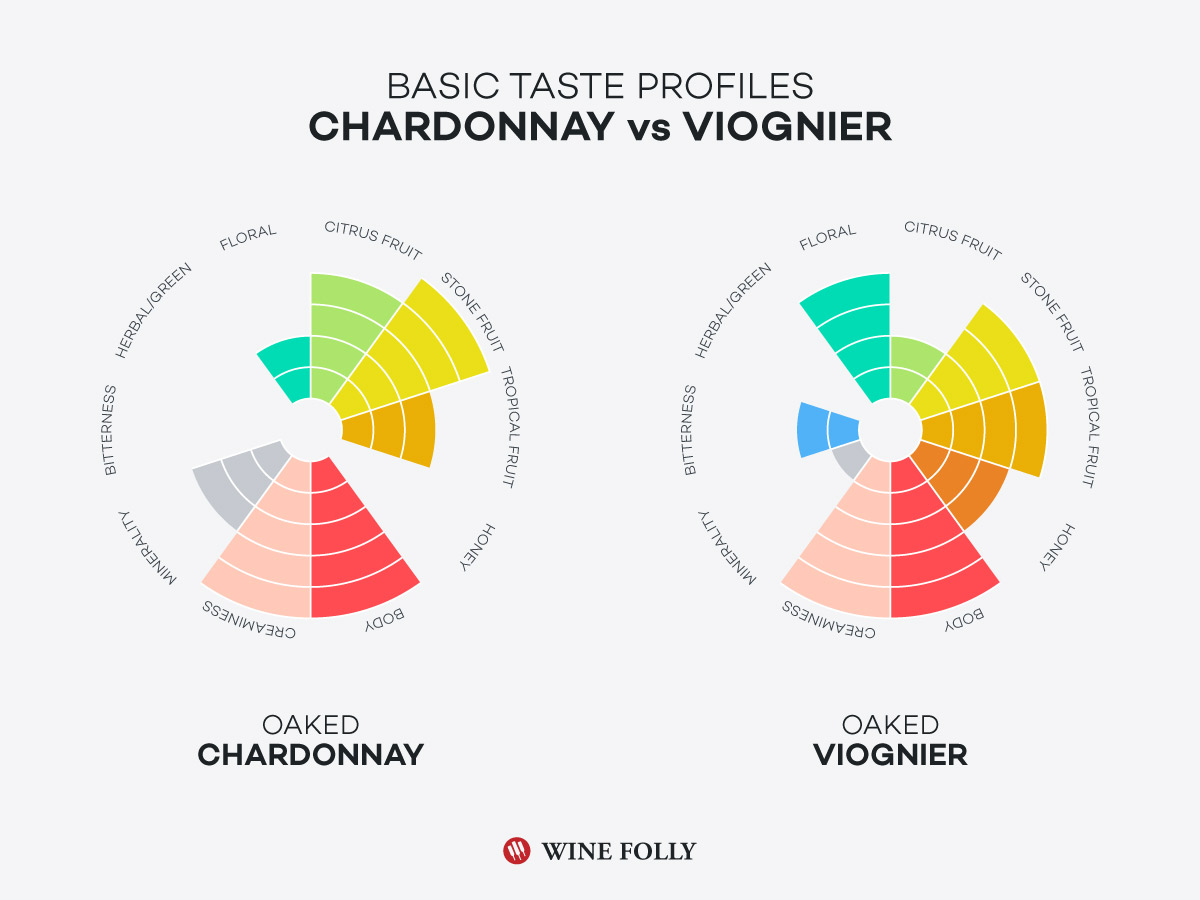Chardonnay and Viognier are both full-bodied white wines but they have subtle textural differences and aromatically are quite distinct. Learn how to identify these wines (even blind) and gain a deeper understanding of how to pair them with food.
Chardonnay versus Viognier Basics: Both are full-bodied white wines and both typically are oak-aged to develop a creamy texture. However, if you focus on the aromatic qualities of Chardonnay and Viognier you’ll find they’re quite different. Learn how their differences make for unique aromatic profiles and food pairings.
Chardonnay vs Viognier
For simplicity’s sake, we’ll be talking about the differences in taste between oaked Chardonnay and oaked Viognier (“Vee-own-yay”). In fact, this comparison is one of the more challenging blind tastings to do. Fortunately, there are some noticeable differences you can learn to identify.
Chardonnay Aromas

Yellow Apple and Lemon
One of Chardonnay’s most identifiable fruit aromas is yellow apple; regardless of where chardonnay is grown, the wine’s aromas almost always center around yellow pomaceous fruit. Of course, some cool-climate unoaked Chardonnays (like Chablis) will have more citrus notes but, for the most part, you can trust that dominant apple and pear aromatics are a highlight of Chardonnay. Beyond this, the citrus notes range from pineapple (on the ripe side) to a more lean lemon zest (on the less-ripe side).
Viognier Aromas

Perfume and Tangerine
Viognier’s primary aromas are dominated by flowery smells of rose petal and exotic perfume. Beyond this, one of the highlight fruit flavors in Viognier is tangerine (sweet citrus, in general). Usually, this doesn’t manifest as fresh, acidic citrus, but more like softer tangerine creamsicle or bergamot candy. Because of the sweetish note that tangerine (and sweet citrus) adds to the aroma profile, you might think that Viognier will have some sugar on the palate, but it’s almost always made in a dry (i.e. no residual grape sugar) style. Viognier will often include a fleshy stone fruit and richer, exotic tropical fruit aroma as well.
Taste Differences
Chardonnay, tends to be more explosive on the start (or “attack) and ends on a creamy, savory note, although this is highly dependent on where the grapes were grown. Viognier, on the other hand, often has a much softer start that builds into an oily feeling on the mid-palate (a characteristic of the grape) to a limey-tangerine note, reminiscent of bitter citrus rind on the finish. In terms of weight, they’re both about the same (when sourced from similar climactic regions). In addition to the citrus, Viognier will often have some more bitter, almond-husk-y aromas on the finish as well.
Food Pairing
Chardonnay
Oaked Chardonnay has a creamy or waxy feeling on the palate, almost no perceived sweetness, and a focus on lemon and yellow apple aromas. Match Chardonnay with foods that use delicate green herbs such as tarragon, savory and thyme, cream (or a similar creamy texture), and leaner “white” proteins including chicken, turkey, pork loin, or scallops.
Viognier
Oaked Viognier has a higher perfumed, aromatic quality and an oily texture that makes it taste slightly less acidic. Seek out foods with Moroccan or Tunisian spices (such as saffron, turmeric, ginger, paprika), root vegetables like carrot, yams and turnip, fruit (apricot and orange), and middle-weight, umami-focused proteins (including butter-poached shrimp or lobster, river fish, pork chops, etc).
Origins
Both grapes originated in France but have different lineages. Chardonnay is part of the Pinot pedigree whereas Viognier is part of the Syrah pedigree. We can infer a couple of things from this observation:
- Finding Great Wines: Expect that regions that produce great Syrah (a warmer climate grape) also tend to produce great Viognier. This relationship is also true between Pinot Noir and Chardonnay (both are cooler climate grapes).
- Finding Great Matches: In terms of gastronomy and food pairing, you could also think about these wines as good counterparts to one another on the table with a meal. Where both Chardonnay and Pinot Noir prefer leaner, delicate foods, Syrah and Viognier can usually handle more flavor (and fat) in a dish.


